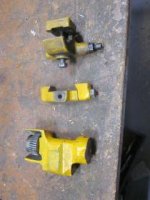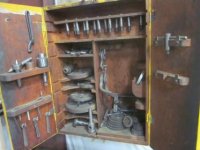Thanks Steve for identifying my 1937 Workshop 415.
I'm trying to learn a bit more about the machine. Are there manual reprints available? I'd love to see what SB said about this machine when it was new.
I have a fair number of tools and accessories with it. A bunch of stuff I've identified, but some are still mysterious. There's a gadget which is meant to engage the feed screw, I think, but I can't see how it bolts on. I believe it's for aiding in thread cutting. There's also a couple of what look like stops, one which kind of fits the cross slide, one which is meant to clamp on the ways. I think.
I also have a wall-mounted box of tools for it. There's what looks like a complete set of gears, which I can't figure out how to use. There's also a set of small collets, but no apparent way to mount them.
I used this machine for years in my friend's shop. He passed without ever explaining what some of this stuff was for, so now it's mine to figure out
Here are a few pix. Any info appreciated.





I'm trying to learn a bit more about the machine. Are there manual reprints available? I'd love to see what SB said about this machine when it was new.
I have a fair number of tools and accessories with it. A bunch of stuff I've identified, but some are still mysterious. There's a gadget which is meant to engage the feed screw, I think, but I can't see how it bolts on. I believe it's for aiding in thread cutting. There's also a couple of what look like stops, one which kind of fits the cross slide, one which is meant to clamp on the ways. I think.
I also have a wall-mounted box of tools for it. There's what looks like a complete set of gears, which I can't figure out how to use. There's also a set of small collets, but no apparent way to mount them.
I used this machine for years in my friend's shop. He passed without ever explaining what some of this stuff was for, so now it's mine to figure out

Here are a few pix. Any info appreciated.







 - nor a threading dial at all
- nor a threading dial at all